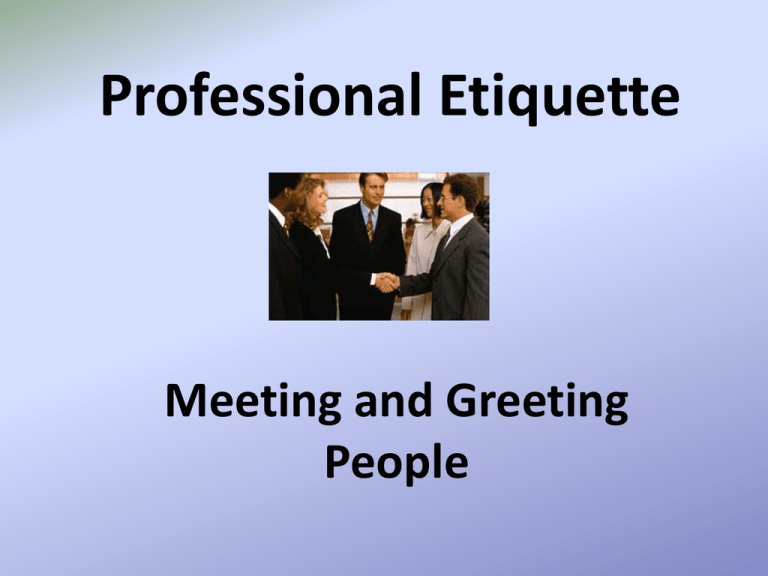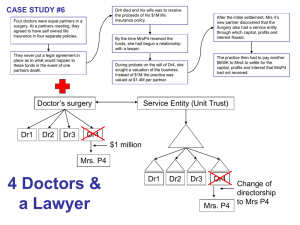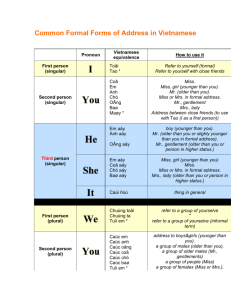
Professional Etiquette
Meeting and Greeting
People
Six Tips to Effectively “Meet and Greet”
1. Stand up
2. Step or lean forward
3. Make eye contact
4. Have a pleasant face
5. Shake hands
6. Greet the other person - repeat their name
How to Shake Hands
Step 1: Extend your right hand to meet the
other person's right hand.
Step 2: Point your thumb upward toward the other person's arm
and extend your arm at a slight downward angle.
Step 3: Wrap your hand around the other person's hand when
your thumb joints come together.
Step 4: Grasp the hand firmly and squeeze gently once.
Remember that limp handshakes are a big turnoff, as are
bone-crushing grasps.
Step 5: Hold the handshake for 2 to 3 seconds.
Step 6: Pump your hand up and down a few times to convey
sincerity. (This gesture is optional.)
Handshake Video Clips
http://www.youtube.com/watch?v=NXiba7_nD0c
http://www.howdini.com/howdini-video-6649828.html
http://www.youtube.com/watch?v=vqC9GJQrngE
Cultural Appropriateness
If you're traveling in a foreign country, you'll have to
do your homework on whether or not a handshake
is an appropriate form of greeting, particularly with
the opposite gender. In some countries, shaking
hands is seen as far too intimate a contact to initiate
with a stranger.
Introducing Yourself
If you were not introduced by someone
else, begin to announce in a loud audible
voice a greeting and your name.
Also add any personal information you think may help
them remember who you are.
“Hello, nice to meet you. I am Eric Jones. I work with
Michelle on the Smith account”
Introductions
• Introduce individuals to each other using both first
and last names.
• If you're introducing someone who has a title , include the title as well
as the first and last names in the introduction.
• If the person you are introducing has a specific relationship to you,
make the relationship clear by adding a phrase such as 'my boss,' 'my
wife' or 'my uncle.' In the case of unmarried couples who are living
together, 'companion' and 'partner' are good choices.
• Use your spouse's first and last name if he or she has a different last
name than you. Include the phrase 'my wife' or 'my husband.'
• Introduce an individual to the group first, then the group to the
individual. For example: 'Dr. Brown, I'd like you to meet my friends
Kym Hsu, Shawn Campbell and Michael Via. Everyone, this is Dr. Kurt
Brown.‘
http://www.youtube.com/watch?v=GqQYS50TyfM
A Man to a Woman
• In the social world, a man is always introduced to
a woman, "Mrs. Brown, may I present Mr. Black," or, "Mrs. Brown, I
should like to present Mr. Black:"
• The word "present" makes this introduction the most formal of all
introductions.
• The same introduction may also be made in the following ways,
"Mrs. Brown, I should like to introduce Mr. Black," or, "Mrs. Brown,
Mr. Black," as it is not necessary to use a sentence in an
introduction.
• Many persons prefer the correct but less formal introduction, "Mr.
Black, have you met Mrs. Brown?" or, "Mr. Black, may I introduce
you to Mrs. Brown." This last, however, is not spoken with the rising
inflection as it is not a question directed to Mr. Black. In all
instances cited, the deference is being shown Mrs. Brown.
Younger Person to Older
• Introduce a younger person to an older person of the
same sex;
"Miss Older, may I present Miss Younger?"
"Miss Older, may I present Mrs. Younger?“
"Miss Younger, have you met Miss Older?"
• An exception to this rule is made if the younger person is the more
distinguished of the two. Others are introduced to a distinguished
person; as, "Miss Distinguished, may I present Mrs. Brown?"
• Never say, "May I present," or, "May I introduce," when introducing
two men; say, "Mr. Older, Mr. Younger," "Mr. Younger, do you know
Mr. Older?" or, "Mr. Younger, have you met Mr. Older?"
Less Prominent to More Prominent
• Introduce the less prominent person to the more
prominent person, regardless of the sex of the
individuals.
• However, if a considerable age difference lies between
the two, it is far more courteous to make introductions
in deference to age, regardless of social rank. For
example:
Arthur Prefect, I'd like you to meet
Dr. Gertrude Smith.
A great rule of thumb:
Always say the name of the most
important person first.
Forgotten names
• The most important thing to remember is that you should
never ignore the introduction and try to muscle through with
everyone acutely aware that you’ve failed to introduce them.
This is just as rude as forgetting someone’s name. In fact, it’s more so.
• When you forget someone’s name, it’s because of poor memory (or
possibly because they’re unmemorable); but when you fail to introduce
people, you’re actively deciding against doing the right thing.
• The most straightforward thing to do is just outright admit that you’ve
forgotten the person’s name. It happens to everyone. Lots of times they’ll
have forgotten yours too and will be grateful to you for admitting first,
essentially letting them off the hook.
• Even if this isn’t the case, the offence of a forgotten name is rarely felt
very strongly, and the sooner you admit it and rectify it the better.
• You can make a special effort to remember the name this time, and be
sure to use it when speaking to the person in the future to reassure them
that you now remember it.
Cultural Gestures
http://soc302.tripod.com/soc_302rocks/id6.html
COLUMBIA
• Women hold forearms instead of shaking hands.
SAUDI ARABIA
• Holding hands or taking someone's elbow is a sign of respect and friendship.
• To place the palm down, fingers spread, with your index finger bent down and pointing
outward is to insult someone.
• Shaking the head from side to side means yes; by tipping the head backward and
clicking the tongue, people signal no.
• Elders tend to greet by saying, Salaam; men greet with a hug and a cheek kiss.
• Veiled women are not introduced.
EGYPT
• Handshakes are followed by a touch on the elbow.
CHINA
• Greeting is usually just a slight nod and bow. Sometimes people will applaud; this
should be responded with applause.
PHILIPPINES
• Greet with a quick flash of the eyebrows.












